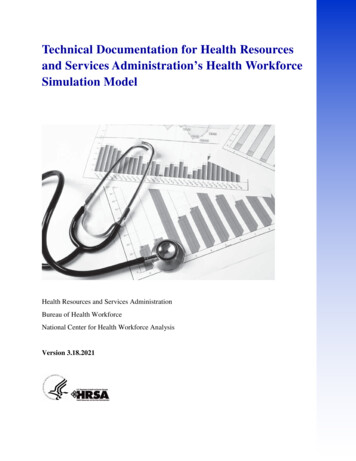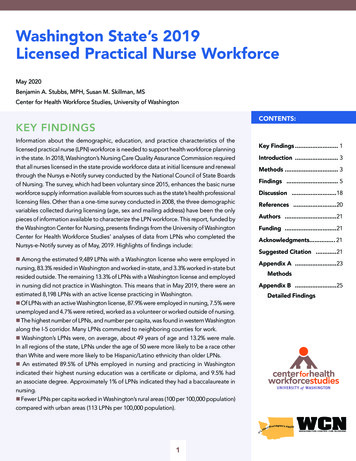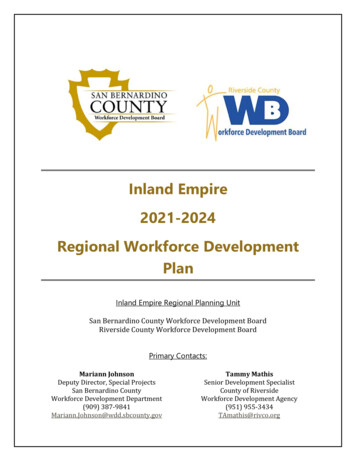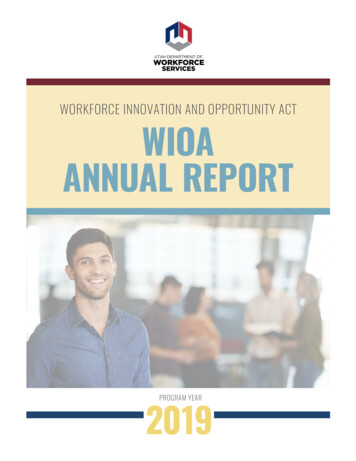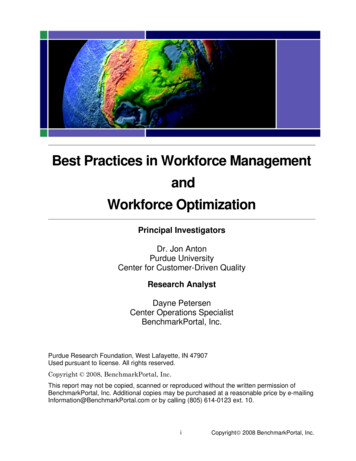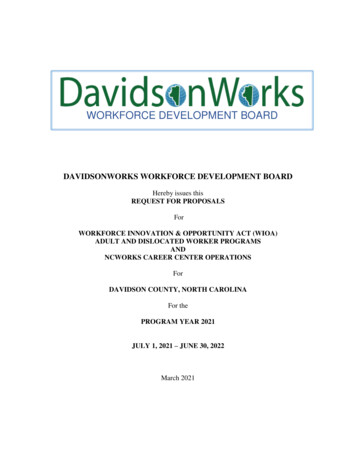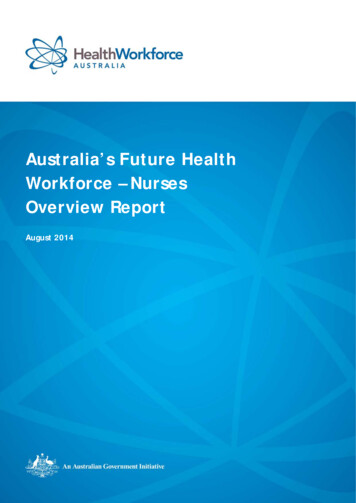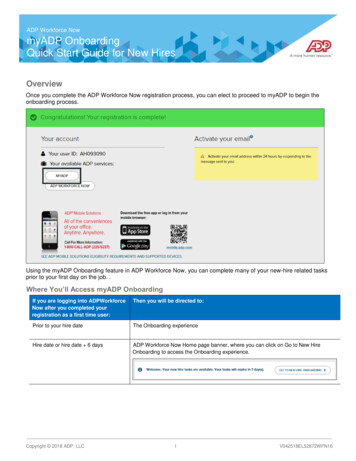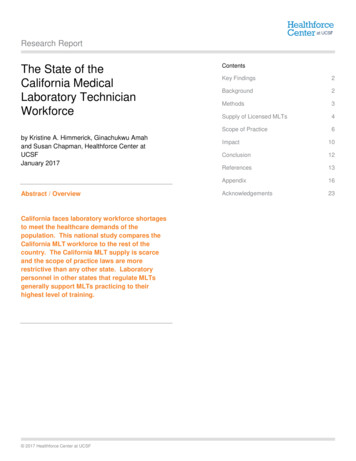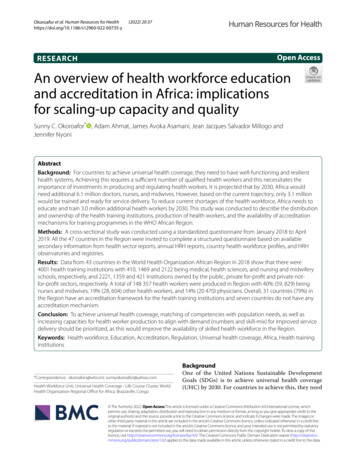
Transcription
Okoroafor et al. Human Resources for 022) 20:37Open AccessRESEARCHAn overview of health workforce educationand accreditation in Africa: implicationsfor scaling‑up capacity and qualitySunny C. Okoroafor* , Adam Ahmat, James Avoka Asamani, Jean Jacques Salvador Millogo andJennifer NyoniAbstractBackground: For countries to achieve universal health coverage, they need to have well-functioning and resilienthealth systems. Achieving this requires a sufficient number of qualified health workers and this necessitates theimportance of investments in producing and regulating health workers. It is projected that by 2030, Africa wouldneed additional 6.1 million doctors, nurses, and midwives. However, based on the current trajectory, only 3.1 millionwould be trained and ready for service delivery. To reduce current shortages of the health workforce, Africa needs toeducate and train 3.0 million additional health workers by 2030. This study was conducted to describe the distributionand ownership of the health training institutions, production of health workers, and the availability of accreditationmechanisms for training programmes in the WHO African Region.Methods: A cross-sectional study was conducted using a standardized questionnaire from January 2018 to April2019. All the 47 countries in the Region were invited to complete a structured questionnaire based on availablesecondary information from health sector reports, annual HRH reports, country health workforce profiles, and HRHobservatories and registries.Results: Data from 43 countries in the World Health Organization African Region in 2018 show that there were4001 health training institutions with 410, 1469 and 2122 being medical, health sciences, and nursing and midwiferyschools, respectively, and 2221, 1359 and 421 institutions owned by the public, private for-profit and private notfor-profit sectors, respectively. A total of 148 357 health workers were produced in Region with 40% (59, 829) beingnurses and midwives, 19% (28, 604) other health workers, and 14% (20 470) physicians. Overall, 31 countries (79%) inthe Region have an accreditation framework for the health training institutions and seven countries do not have anyaccreditation mechanism.Conclusion: To achieve universal health coverage, matching of competencies with population needs, as well asincreasing capacities for health worker production to align with demand (numbers and skill-mix) for improved servicedelivery should be prioritized, as this would improve the availability of skilled health workforce in the Region.Keywords: Health workforce, Education, Accreditation, Regulation, Universal health coverage, Africa, Health traininginstitutions*Correspondence: okoroafors@who.int; sunnyokoroafor@yahoo.comHealth Workforce Unit, Universal Health Coverage - Life Course Cluster, WorldHealth Organization Regional Office for Africa, Brazzaville, CongoBackgroundOne of the United Nations Sustainable DevelopmentGoals (SDGs) is to achieve universal health coverage(UHC) by 2030. For countries to achieve this, they need The Author(s) 2022. Open Access This article is licensed under a Creative Commons Attribution 4.0 International License, whichpermits use, sharing, adaptation, distribution and reproduction in any medium or format, as long as you give appropriate credit to theoriginal author(s) and the source, provide a link to the Creative Commons licence, and indicate if changes were made. The images orother third party material in this article are included in the article’s Creative Commons licence, unless indicated otherwise in a credit lineto the material. If material is not included in the article’s Creative Commons licence and your intended use is not permitted by statutoryregulation or exceeds the permitted use, you will need to obtain permission directly from the copyright holder. To view a copy of thislicence, visit http:// creat iveco mmons. org/ licen ses/ by/4. 0/. The Creative Commons Public Domain Dedication waiver (http:// creat iveco mmons. org/ publi cdoma in/ zero/1. 0/) applies to the data made available in this article, unless otherwise stated in a credit line to the data.
Okoroafor et al. Human Resources for Health(2022) 20:37to have well-functioning and resilient health systemsto ensure access of the populations to health care services [1]. However, having well-functioning and resilient health systems requires, among other things, asufficient number of qualified health workers [2]. Hencethe challenges of producing them, then the capacity forrecruiting, deploying and retaining them, requires sustainable investments [3].There remains a continual low investment in the education of health workers and a gross mismatch withthe disease burden and population needs [4–6]. Thishas contributed to marked shortages of health workers as well as low absorption of health workers intohealth systems. Towards achieving UHC, the GlobalStrategy on Human Resources for Health (HRH) highlights the need for collaboration amongst relevant sectors in ensuring a balance in the health system needs,population needs, education, demand and fiscal spacefor health workers [7]. Furthermore, investment ofthe private sector in the education of health workersis essential to boost the production of health workers.Still, there needs to be strong regulatory mechanisms inplace to ensure quality training modalities and competence of tutors and trainees [7, 8].Recent literature has also indicated that poor adherenceand enforcement of standards for professional education,licensing, and practice is widespread in the health sector [9–12]. This has been attributed to the global call foran increase in the production and distribution of healthworkers with efforts geared towards achieving this withquality and professionalism often neglected [10]. Thisoften results in health workers leaning on their discretionin providing services taking into cognizance the levity ofprofessional norms and standards [13]. Often this mayresult in actions that may not necessarily be beneficial tothe patient and population [10].In 2005, the Africa Region of the World Health Organization (WHO) had only 1.56 million health workers or3% of the global health workforce stock [14]. Thirteen(13) years on, Africa’s health workforce stock increasedto 3.57 million in 2018, representing a 129% increase[14]. However, adjusting to the growth of the population,there was only 61% improvement over 13 years, thus 4.7%real growth in the density of health workers per annum.Despite this increase in the stock of health workers, thedensity of doctors, nurses, and midwives per 10 000 population in the Region is 15.4 compared to 44.5 neededto attain the median rank of the SDG tracer indicators.Thus, the Africa Region has only 34.6% of the requireddoctors, nurses, and midwives. It is projected that by2030, Africa would need additional 6.1 million doctors,nurses, and midwives but in the current trajectory, only3.1 million would have been trained and ready for servicePage 2 of 7delivery [7, 14]. To reduce current shortages of the healthworkforce, Africa needs to educate and train 3.0 millionadditional health workers by 2030 to provide the mostessential health services [7].A scale-up of this magnitude of health workforce willrequire significant human and financial resources investment to build the human and institutional capacity necessary to produce more health workers and to retainthem. The production of health workers in Africa isconstrained by limited capacities in terms of shortagesof qualified teaching faculty staff, limited teaching andlearning materials, as well as inadequate infrastructureand environment for both learning and living for studentsand lecturers. In addition, the quality of training and thehealth professionals have continued to be a challenge[15]. There are increasing concerns about the functionalaccreditation mechanisms in place for health traininginstitutions and programmes. Accreditation of a traininginstitution is the quality control procedure aimed at theofficial recognition and approval of the training institution or programme after verification of compliance withcertain predefined standards by an external body officially designated or recognized for this purpose [16]. Onthe other hand, retention of health workers is dependenton numerous contextual factors and suggested to requirea combination of incentives ranging from enrolment ofstudents of deprived backgrounds, mandatory rural postings, availability of social amenities, enhanced workingconditions, etc. [17–20].The paper presents the distribution and ownership ofthe health training institutions across the WHO AfricanRegion. We also provide insights on the number of healthworkers produced, and the availability of accreditationmechanisms for training programmes in the Region.MethodsA cross-sectional study was conducted using a standardized questionnaire on the distribution and availability ofaccreditation mechanisms for health training institutionsin countries in the WHO African Region from January2018 to April 2019. All the 47 countries in the Regionwere invited to complete a structured questionnairebased on available secondary information from healthsector reports, annual HRH reports, country healthworkforce profiles, and HRH observatories and registries.The questionnaire was designed to collect information onthe training institutions (faculties, colleges and schools)for the health occupational categories/cadres groupedinto medical training institutions (medical practitioners,dentists and pharmacists), nursing and midwifery, andhealth sciences for other mid-level cadres not capturedpreviously. Ownership of the training institutions (public,private for-profit, and private not-for-profit), the number
Okoroafor et al. Human Resources for Health(2022) 20:37of graduates produced by the training institutions, andthe availability of an accreditation body for the healthtraining institutions were also obtained. Countries wereoriented on the questionnaire during a virtual meeting.The questionnaire was completed by the designated staffof the Ministries of Health on behalf of countries andsigned off by the Directors/Heads of the HRH department. All questionnaires were completed in English orFrench by all countries.The completed questionnaires were reviewed for completeness, data entry and a quality check were doneusing Epi Info, and analysis was conducted using Microsoft Office Excel. Of the 47 countries in the Region, 43countries responded giving a response rate of 91%. Thecountries were Algeria, Angola, Benin, Botswana, Burkina Faso, Burundi, Cape-Verde, Central African Republic, Chad, Congo, Cote d’Ivoire, Democratic Republicof Congo, Eritrea, Eswatini, Ethiopia, Gabon, Gambia,Ghana, Guinea, Guinea-Bissau, Kenya, Lesotho, Liberia, Madagascar, Malawi, Mali, Mauritania, Mauritius,Mozambique, Namibia, Niger, Nigeria, Rwanda, Senegal,Seychelles, Sierra Leone, South Africa, South Sudan,Tanzania, Togo, Uganda, Zambia and Zimbabwe. Cameroun, Comoros, Equatorial Guinea and Sao Tome andPrincipe did not complete the survey.ResultsHealth training institutions by countryOverall, there were 4001 health training institutions inthe 43 countries that responded as shown in Table 1. Onethousand and twenty-eight (26%) of the institutions werelocated in Nigeria, 870 (22%) in the Democratic Republic of Congo, and 281 (7%) in Tanzania. Four hundredand ten (410) of the 4001 health training institutions(10%) were medical training institutions with the Democratic Republic of Congo, Nigeria and Ethiopia havinga total of 190 (46%) of the 410 medical training institutions in the Region (Democratic Republic of Congo—102(25%), Nigeria—52 (13%) and Ethiopia—36 (36%)). Thehealth sciences training institutions were 1,469 (37% ofthe health training institutions) with 1104 (75%) of the1469 health sciences training institutions are located infour (4) countries: Nigeria—714 (49%), Tanzania—185(13%), Democratic Republic of Congo—110 (7%) andAngola—95 (6%)). Fifty-three percent (2122) of thehealth training institutions in the Region are for training nurses and midwives. Of this number, 50% (1054) arein the Democratic Republic of Congo (658 representing31%), Nigeria (262 representing 12%) and Chad (134 representing 6%).Page 3 of 7Ownership of training institutionsTable 2 shows that of the 4001 health training institutions in the Region, 2221 (56%) were owned by the publicsector, and 44% by the private sector 1359 (34%) by theprivate for-profit sector and 421 (10%) by private not-forprofit sector). In addition, 53% (2122) of the institutionswere nursing and midwifery institutions, 37% (1469)were health sciences institutions, and 10% (410) weremedical training institutions. 64% (264) of the 410 medical training institutions were owned by the public sector,27% (111) by the private for-profit sector, and 9% (35) bythe private not-for-profit. For the health sciences institutions, 69% (1015), 25% (367) and 6% (87) are owned bythe public, private for-profit and private not-for-profitsectors, respectively.Production of health workersA total of 148 357 health workers were produced in theAfrica Region in 2018 (Fig. 1). Of this 40% (59, 829) werenurses and midwives, 19% (28, 604) other health workers, and 14% (20 470) physicians. Health informationtechnologists (11 639) and community health workers (11 447) comprised 8%, and laboratory officers andtechnicians, and dentists and technicians comprised 5%(6727) and 4% (6138), respectively. Forty percent of allhealth workers were produced by public sector-ownedhealth institutions (n 59 226) with 54% (n 10 992) ofphysicians, 53% (n 6025) community health workers,46% (n 2860) pharmacists and technicians and 43%(25 452) nurses and midwives graduating from publicsector-owned schools.Accreditation mechanisms for training institutionsTo ascertain the progress made by countries towardsstrengthening the capacity and quality of educationalinstitutions through their accreditation of programmesin their training schools, countries were asked to provideinformation on the availability of a national accreditation mechanism for health training institutions. Figure 2shows the percentage of countries with accreditationmechanisms in place of the 39 countries that providedinformation. Thirty-one (31) countries (79%) had anaccreditation framework for health training institutions. The countries with accreditation mechanismswere Angola, Botswana, Burundi, Cape-Verde, CentralAfrican Republic, Cote d’Ivoire, Democratic Republicof Congo, Eritrea, Eswatini, Ethiopia, Gabon, Ghana,Guinea, Guinea-Bissau, Lesotho, Liberia, Madagascar,Malawi, Mauritius, Mozambique, Namibia, Niger, Nigeria, Rwanda, Senegal, Seychelles, Sierra Leone, Tanzania, Uganda, Zambia and Zimbabwe. Algeria, Benin,
Okoroafor et al. Human Resources for Health(2022) 20:37Page 4 of 7Table 1 Distribution of health training institutions by countryCountry nameMedical traininginstitutionsHealth sciencesinstitutionsNursing and 1Benin210214Botswana23712Burkina Faso44851103Burundi4251948Cape-Verde58518Central African Republic161Chad23134Congo216Cote d’Ivoire401Democratic Republic of egal535563Seychelles–112Sierra Leone1––1South Africa*28––28South nstitutions in these countries provided training programmes for all health occupational categories/cadresTotal81399587017461028494001
Okoroafor et al. Human Resources for Health(2022) 20:37Page 5 of 7Table 2 Distribution of health training institutions by sectorTraining institutionsPublic sectorPrivate for-profit sectorPrivate not-for-profitsectorTotalNumber (%)Number (%)Number (%)Number (%)Medical training institutions26464%11127%359%41010%Health sciences institutions101569%36725%876%146937%Nursing and midwifery 35934%42110%4001100%Other health workers10404Laboratory officers and technicians34042275634141622300Community Health Workers5106095Health Information Technologists164236817131643281092622Dentists and Technicians475682938Pharmacists and Technicians2820Nurses and c sector40%Private sector50%Faith based 0%90%100%Sector not specifiedFig. 1 Annual graduates in the African Region in 2018Burkina Faso, Congo, Mali, Mauritania and Togo (18% ofthe countries) do not have an accreditation mechanism.Chad was in the process of establishing an accreditationmechanism at the time of the study.DiscussionFor countries to achieve UHC, they need to invest inensuring the availability of qualified, skilled, and motivated health workers [21, 22] and this can be achieved byincreasing production, retention and regulation capacities [9, 18]. Concerted efforts should aim at increasingthe numbers, distribution and production capacity inthe Region to produce 3 million additional health workers by 2030 and this should be led by countries. The evidence on the health systems and population needs shouldbe matched to supply and demand for health workers[7, 22]. To achieve this, leadership, coordination andplanning for the health workforce should be strengthened. Investment in pre-service education applying anintersectoral approach with relevant ministries and parastatals (health, education, finance, planning and budgeting) should be scaled–up [7, 23]. Matching competencieswith population needs, as well as increasing capacities forhealth worker production and recruitment to align withdemand (numbers and skill-mix) for service delivery,will improve the availability of skilled health workforceneeded to achieve UHC. Additionally, harmonization ofcurricula, education standards, accreditation, and professional regulation across all levels and sectors, as well aspromoting career progression and retention of tutors willultimately ensure that a fit-for-purpose health workforce
Okoroafor et al. Human Resources for Health(2022) 20:37In process3% (1 country)No18%(7 countries)Yes79% (31 countries)In processNoYesFig. 2 Percentage of countries with an accreditation body for healthtraining institutions in the African Region (N 39)is available to deliver integrated health services andimprove the health indices in the Region [22, 24].Our findings indicate that the private sector wasactively investing in health workforce education andthereby contributing to increasing the production capacity in the Region. Whilst this is laudable and should beencouraged, countries need to ensure policies are in placeto encourage potential investors and ensure alignmentof quality standards in the public and private sectors[7, 8]. These policies should focus on ensuring neededinfrastructure for quality training is in place, enrolmentprocesses are based on gender and other equity considerations, the processes of selecting students consider sociodemographic factors to ensure retention after graduation,and tutors have relevant experience and qualifications [7,25].In addition, countries need to ensure that effortsaimed at increasing the production capacity should becomplemented with strong governance and regulatoryframeworks to ensure that quality and accountability isensured [10, 21]. This is pertinent as weak HRH regulation and non-participation of regulatory bodies in HRHplanning and development are evident in some countries.Additionally, variations in technical competencies, skillsand professionalism amongst qualified health workershave been reported due to varied standards of education and poor regulation [10, 11, 26]. This has resultedPage 6 of 7in fragmentation of HRH regulation and practice andthe weakening of the regulatory bodies and processes.Furthermore, the non-alignment of global, regional andnational policy reforms with professional regulationand practice have been impeding service delivery andthe achievement of health sector goals at various levels.Therefore, there is a need to foster the active participation of professional regulatory bodies in HRH planningand development. The establishment or strengthening ofprofessional regulatory bodies to enforce laws and regulations including HRH accreditation, systems for licensure, professional development, disciplinary measures,education standards, quality assurance, codes of conductand scopes of practice [25, 27] will promote ethical practices and accountability. Harmonizing the practices andregulations of professional regulatory bodies betweenprofessions and across all levels will also foster inter-professional collaboration and reduce rivalries. Ultimately,functional regulatory mechanisms will ensure the availability of qualified, skilled, responsive and productivehealth workers, quality of care and a well-performinghealth system [28]. By ensuring adequate regulation,optimal standards of care will be provided, the population will be protected from harm, health workers wouldbe accountable as incompetence and negligence would beat the barest minimum, and inefficiencies would be eliminated [28, 29].ConclusionThe Africa Region is faced with shortages of health workers, and low production and regulatory capacities. Thisis compounded by a prolonged low investment in theeducation of health workers and a gross mismatch withthe disease burden and population needs. To close theprojected shortfall of 6.1 million doctors, nurses, andmidwives by 2030, the countries in the Region need toincrease the production and distribution of health workers, and this should be complemented by establishing/strengthening and enforcing the standards for professional education, licensing, and practice. This wouldultimately improve the availability of skilled health workforce needed to achieve universal health coverage.AcknowledgementsWe acknowledge the support of the government stakeholders and WHOCountry Offices in Africa Region that provided the information that was usedto develop this paper.Author contributionsAll authors conceived, designed and conducted the study. SCO and AA analysed the data and wrote the initial manuscript. All authors read and approvedthe final manuscript.
Okoroafor et al. Human Resources for Health(2022) 20:37Availability of data and materialsThe data for the findings are available on request from the health workforceunit of WHO AFRO.DeclarationsEthics approval and consent to participateNot applicable.Consent for publicationNot applicable.Competing interestsThe authors declare that they have no competing interests.Received: 10 March 2022 Accepted: 26 April 2022References1. Zurn P, Zapata T, Okoroafor SC. The importance of strengthening thehealth workforce in Nigeria to improve health outcomes. J Public Health.2021;43(Supplement 1):i1–3.2. Campbell J, Dussault G, Buchan J, Pozo-Martin F, Guerra Arias M, LeoneC, Siyam A, Cometto G. A universal truth: no health without a workforce.Forum Report, Third Global Forum on Human Resources for Health,Recife, Brazil. Geneva: Global Health Workforce Alliance and World HealthOrganization; 2013.3. Frenk J, Chen LC, Michaud C. Transformative learning in health educationfor a new century: interdependence in the education of health professionals, in financing the education of health workers: gaining a competitive edge. Singapore: World Scientific; 2019. p. 1–30.4. Scheffler RM, et al. Forecasting imbalances in the global health labor market and devising policy responses. Hum Resour Health. 2018;16(1):1–10.5. WHO, The World Health Report 2006—working together for health.Geneva: World Health Organization. 2006, World Health Organization:Geneva.6. Liu JX, et al. Global health workforce labor market projections for 2030.Hum Resour Health. 2017;15(1):1–12.7. WHO. Global strategy on human resources for health: workforce 2030.Geneva: World Health Organization; 2016.8. Hazarika I. Health workforce in India: assessment of availability,production and distribution. WHO South-East Asia J Public Health.2013;2(2):106–12.9. Aftab W, et al. Variations in regulations to control standards for trainingand licensing of physicians: a multi-country comparison. Hum ResourHealth. 2021;19(1):1–10.10. Khan MS, et al. Is enhancing the professionalism of healthcare providerscritical to tackling antimicrobial resistance in low-and middle-incomecountries? Hum Resour Health. 2020;18(1):1–9.11. Frenk J, et al. Health professionals for a new century: transforming education to strengthen health systems in an interdependent world. Lancet.2010;376(9756):1923–58.12. Horton R. A new epoch for health professionals’ education. Lancet.2010;376(9756):1875–7.13. Hanefeld J, Powell-Jackson T, Balabanova D. Understanding and measuring quality of care: dealing with complexity. Bull World Health Organ.2017;95(5):368.14. WHO. The State of the Health Workforce in the WHO African Region. 2021:Brazzaville.15. Asamani JA, et al. Towards a regional strategy for resolving the humanresources for health challenges in Africa. BMJ Glob Health. 2019;4(Suppl9): e001533.16. Afriyie DO, Nyoni J, Ahmat A. The state of strategic plans for the healthworkforce in Africa. BMJ Glob Health. 2019;4(Suppl 9): e001115.17. WHO, Retention of the health workforce in rural and remote areas: asystematic review: web annex A: GRADE evidence profiles. 2020: Geneva.Page 7 of 718. Okoroafor SC, et al. Retention and motivation of health workers in remoteand rural areas in Cross River State, Nigeria: a discrete choice experiment.J Public Health. 2021;43(Supplement 1):i46–53.19. Okoroafor SC, et al. Perspectives of policymakers and health care managers on the retention of health workers in rural and remote settings inNigeria. J Public Health. 2021;43(Supplement 1):i12–9.20. WHO. Increasing access to health workers in remote and rural areasthrough improved retention. Global policy recommendations. Geneva:World Health Organization; 2010.21. Reich MR, et al. Moving towards universal health coverage: lessons from11 country studies. Lancet. 2016;387(10020):811–6.22. Sousa A, et al. A comprehensive health labour market framework foruniversal health coverage. Bull World Health Organ. 2013;91:892–4.23. Feyissa GT, Balabanova D, Woldie M. How effective are mentoringprograms for improving health worker competence and institutionalperformance in Africa? A systematic review of quantitative evidence. JMultidiscip Healthc. 2019;12:989.24. Touré CO, et al. Accreditation of private midwifery and nursing schoolsin Mali: a local sustainable solution to increasing the supply of qualifiedhealth workers. Hum Resour Health. 2021;19(1):1–8.25. WHO. National health workforce accounts: a handbook. Geneva: WorldHealth Organization; 2017.26. Green A. HIV epidemic in children in Pakistan raises concern. Lancet.2019;393(10188):2288.27. Cometto G, Buchan J, Dussault G. Developing the health workforce foruniversal health coverage. Bull World Health Organ. 2020;98(2):109.28. Dejene D, et al. Exploring health workforce regulation practices andgaps in Ethiopia: a national cross-sectional study. Glob Health Res policy.2019;4(1):1–12.29. Organization, W.H., Transforming and scaling up health professionals’education and training: World Health Organization guidelines 2013. 2013:World Health Organization.Publisher’s NoteSpringer Nature remains neutral with regard to jurisdictional claims in published maps and institutional affiliations.Ready to submit your research ? Choose BMC and benefit from: fast, convenient online submission thorough peer review by experienced researchers in your field rapid publication on acceptance support for research data, including large and complex data types gold Open Access which fosters wider collaboration and increased citations maximum visibility for your research: over 100M website views per yearAt BMC, research is always in progress.Learn more biomedcentral.com/submissions
additional health workers by 2030 to provide the most essential health services [7]. A scale-up of this magnitude of health workforce will require signicant human and nancial resources invest-ment to build the human and institutional capacity nec-essary to produce more health workers and to retain them. e production of health workers in Africa is

